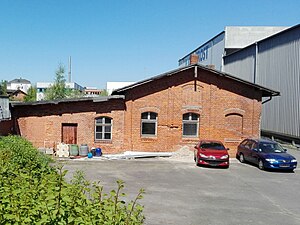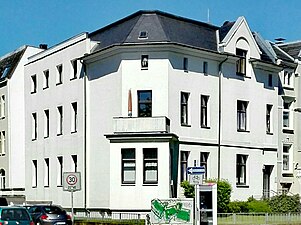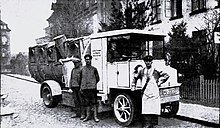Alexander König (manufacturer)
Alexander Claus König (born March 7, 1873 in Wandsbek ; † January 14, 1928 in Lübeck ) was a manufacturer who did a great job in the industry and banking of the Hanseatic city.
Life
On March 18, 1868, the issued Prussian government due to the abuses in the battle industry and the widespread use of trichinosis , the law on "construction of public, only to-use slaughterhouses," the so-called "battle forced law" that the construction of municipal encourage slaughterhouses and then Prohibition of private slaughterhouses should allow. After the founding of the German Reich , the Senate of the now associated member state of Lübeck decided in 1871 to extend its validity to itself. However, the dispute between the Senate and the Guild that followed the decision delayed its implementation in 1883. By enacting the Lübsche Slaughter Law in 1883.
The Senate adopted in 1884 by decree of Lübsche battle forced law and decided by Rats- and civil decision by the plans of Ferdinand Herman Arnold coins Bergers first Luebeck slaughterhouse on the Rodde coupling between the Schwartau Avenue and Catharinenstrasse to build. The previously privately operated Küterhäuser on the Wakenitz and the Krähenteich had to be closed.
The location of the general slaughterhouse was chosen so that the slaughter cattle came by cattle drive across the Triftstraße , by rail from Holstein and by ship from Fehmarn or from Denmark and Sweden . Opposite the Wallhafen, a quay with a cattle yard, St. Lorenz-Platz , was built on the still unpaved side of the Roddenkoppel . A Triftstraße led over the tracks of the Lübeck-Büchener railway , from 1892 port railway , and that of the Eutin-Lübeck railway on the Catharinenstraße and there in the Schlachthof-Straße. The slaughterhouse and the cattle market hall were located on Catharinenstrasse .
After the Reich epidemic law was tightened in 1894, imported cattle were initially to be kept in quarantine. A quarantine station was therefore built behind the tracks of the Viehtrift in 1895 .
As the only such networked facility, the slaughterhouse was to develop into the largest company of its kind in the German Reich and in the entire Baltic region. The unity of port, railroad, slaughterhouse and, from 1912, a cold store was important for the supply of Germany and also for the economic prosperity of the city at this time and during both world wars .
career
The steam tallow melting and edible fat factory "Carstens & Hölterling", founded in 1891 by Johannes Carstens and Stephanus Christian Heinrich Hölterling, settled in the further processing of slaughterhouse waste in the form of tallow and fatty tissue . at the general slaughterhouse at Schwartauer Allee 70 / 70a .
Due to a ban on the import of live cattle in 1926, a sea border slaughterhouse was built in 1928/29 , the building complex of which went into operation on October 1, 1929. Today, like the factory, it is empty and left to decay . As the only preserved sea border slaughterhouse in Germany, its ruins were placed under monument protection in 2016 .
When Carstens left the company in 1895, his nephew, the businessman Alexander König, joined the company as a partner at his request and became its owner after Hölterling also left the company in 1899 . Since vision and reliability were among its distinctive features, it developed into a specialist shop whose products were known far beyond national borders.
König met the cattle dealer Christian Carl Heinrich Hamann. When Hamann wanted to sell the villa , his father-in-law bought it and the entire family moved to Arnimstrasse 23 in Lübeck in 1898 . Even today you can read on the house: "If you want to earn respect, you must not keep your hands still."
In 1900 the König family moved to Catharinenstraße 21 , 1902 to Schwartauer Allee 16a , 1903 to Schwartauer Allee 22a , 1904 to Hansastraße 9 , 1908 to Hansastraße 15 and on April 1, 1909 back to Schwartauer Allee . His apartment was in house number 67 across from Schlachthof Strasse . When Martha's mother died, her house was transformed, initially into a summer house . During the World War Martha and her children moved from the factory to the house. In the year after the war, König also moved there.
His characteristics allowed König to be active outside his company in prestigious industrial and commercial enterprises. He was chairman of the supervisory board of Moll Aktiengesellschaft and eight years as chairman of the supervisory board of the advance and savings bank. He was also a member of the supervisory boards of the Hochseefischerei Aktiengesellschaft “Trave” , the Heinr fish industry. Ihde ref. GmbH and the Schlutuper Kistenfabrik .
On the evening of January 14, 1928, at around 7 a.m., König suffered a stroke and died. His burial took place on the 19th in the Burgtorfriedhof .
Lübeck garbage disposal
After recognizing the viability of a company he had found to be good, König acted as its patron , regardless of whether he exposed himself to attacks from the left or the right . An example of this was the emergence of Transport - and garbage disposal - Aktiengesellschaft , Lübeck that after him appointed to its Board, in 1926. In the lübeckischen waste disposal , he is considered idea imaging founder . At the end of 1927, the removal of rubbish and faeces, previously carried out by gardeners as a part-time job , was put on a contemporary basis. The large tubes resembling electric waste collection Automobile ( tankers ) she drove dust-free and odorless off. The garbage was taken to the low-lying Lohmühlenwiesen to raise it, the feces were left to the gardeners to fertilize their lands . The newspapers justified the accusation that the Hanseatic city had therefore waited so long to adapt its garbage disposal to the hygienic and technical requirements , at the time with the advantage that it would now actually be on the same level as the most advanced large cities in this area .
family
König was married to Martha, née Meyer, (* March 20, 1873, † January 23, 1948) in Hamburg. The marriage had three children.
- Ernst-Ludwig, (1909–1966)
- Margarethe, (1905–1971)
Web links
literature
- Alexander Claus King. von Lüthgens in: Lübeckische Blätter , 70th year, no. 7, edition of February 12, 1928, pp. 110–111.
- Merchant Alexander König †. In: Lübeckische advertisements , Volume 177, No. 13, edition of January 16, 1928.
- Alexander King †. In: Lübecker General-Anzeiger , Volume 47, No. 14, edition of January 17, 1928.
Individual evidence
- ↑ Munzenberger also planned, among other things, the slaughterhouse in Wismar and in Lübeck the former cathedral museum and the former synagogue in the then Moorish style . He was responsible for the construction management of a number of large urban buildings, such as the old Reich Post Office building on the market , the headquarters of the German Life Insurance Company at Königstrasse 1/3 and the Herz-Jesu-Kirche at the parade .
- ↑ The Schwartau Avenue is an old country road after Schwartau . Coming from Schwartau it counted upwards and was called Schwartauer Chaussee . In the Luebeck area, the avenue counted upwards from Fackenburger Allee . The Chaussee was partially converted into an avenue when it became Lübeck, for example through the incorporation of the village of Vorwerk .
- ↑ In 1911 the Catharinenstrasse was renamed Katharinenstrasse .
- ↑ The Schlachthofstraße was across the Dröge road and today is Matthew Street .
- ↑ The cold store was built in 1912 by Kühlhaus Lübeck AG , today part of the Nordfrost Group. It was demolished again in 1987 .
- ↑ The company "Carstens & Hölterling" existed until the 1980s.
- ↑ Slaughterhouse placed under monument protection
- ↑ Arnimstrasse was named in 1869 after Major Arnim , who fell as leader of the Hanseatic Legion in Wesloe in 1813 on the day after the attack near Dassow .
- ↑ The Hansastraße 1876 to commemorate the Hanseatic named accordingly. In the 1980s the name of the street was changed to Hansestrasse .
- ↑ The garbage collection then and now. (End.) In: Vaterstädtische Blätter , year 1929/30, No. 25, edition of September 13, 1930, p. 101.
- ↑ Lübeck garbage disposal. In: Vaterstädtische Blätter , year 1927/28, No. 13, edition of March 18, 1928, p. 52.
| personal data | |
|---|---|
| SURNAME | King, Alexander |
| ALTERNATIVE NAMES | King, Alexander Claus |
| BRIEF DESCRIPTION | German merchant, manufacturer and patron |
| DATE OF BIRTH | March 7, 1873 |
| PLACE OF BIRTH | Wandsbek |
| DATE OF DEATH | January 14, 1928 |
| Place of death | Lübeck |








